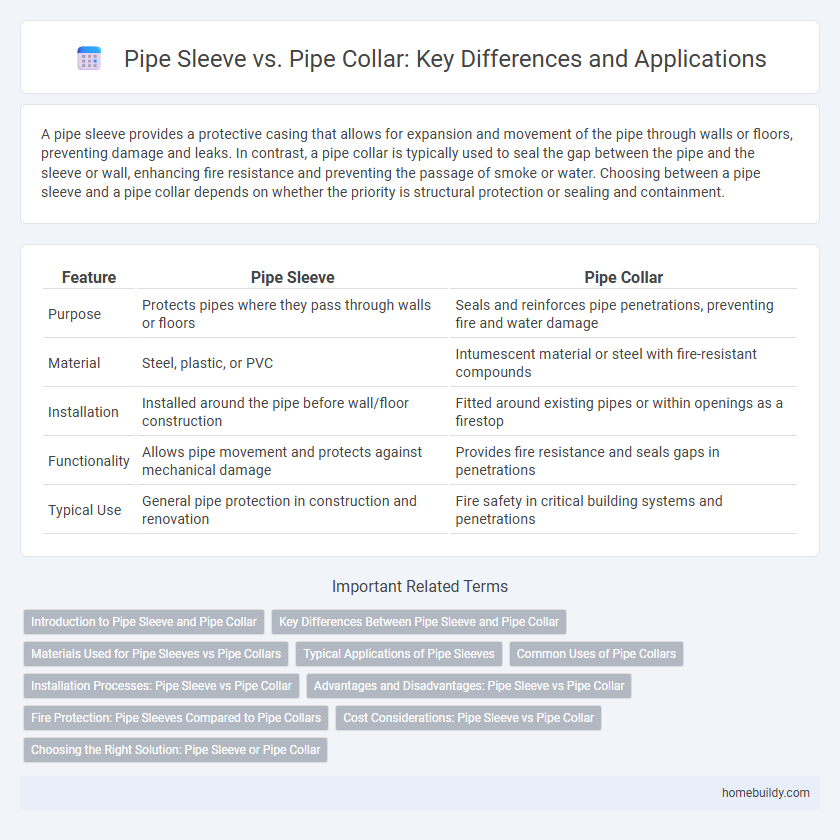A pipe sleeve provides a protective casing that allows for expansion and movement of the pipe through walls or floors, preventing damage and leaks. In contrast, a pipe collar is typically used to seal the gap between the pipe and the sleeve or wall, enhancing fire resistance and preventing the passage of smoke or water. Choosing between a pipe sleeve and a pipe collar depends on whether the priority is structural protection or sealing and containment.
Table of Comparison
| Feature | Pipe Sleeve | Pipe Collar |
|---|---|---|
| Purpose | Protects pipes where they pass through walls or floors | Seals and reinforces pipe penetrations, preventing fire and water damage |
| Material | Steel, plastic, or PVC | Intumescent material or steel with fire-resistant compounds |
| Installation | Installed around the pipe before wall/floor construction | Fitted around existing pipes or within openings as a firestop |
| Functionality | Allows pipe movement and protects against mechanical damage | Provides fire resistance and seals gaps in penetrations |
| Typical Use | General pipe protection in construction and renovation | Fire safety in critical building systems and penetrations |
Introduction to Pipe Sleeve and Pipe Collar
Pipe sleeves protect pipes by providing a barrier that prevents damage from concrete or structural movement, ensuring durability and ease of maintenance. Pipe collars are installed around pipes to seal and secure the pipe where it passes through walls or floors, primarily preventing leaks and fire spread. Both components are essential in construction for pipe integrity but serve distinctly different protective functions.
Key Differences Between Pipe Sleeve and Pipe Collar
Pipe sleeves and pipe collars serve different purposes in construction and plumbing systems, with pipe sleeves primarily designed to protect pipes as they pass through walls or floors, providing a barrier against damage and facilitating pipe movement. Pipe collars, on the other hand, are used to seal around pipes where they penetrate fire-rated walls or floors, enhancing fire resistance by preventing the spread of flames and smoke. Key differences include the pipe sleeve's role in physical protection and movement allowance versus the pipe collar's focus on firestopping and sealing capabilities.
Materials Used for Pipe Sleeves vs Pipe Collars
Pipe sleeves are commonly made from materials such as PVC, steel, stainless steel, or rubber, chosen for their durability and corrosion resistance in protecting pipes through walls and floors. Pipe collars, typically constructed from metal alloys like galvanized steel or cast iron, provide a seal around pipes to prevent water, fire, or gas leakage. The material selection for pipe sleeves emphasizes protection and insulation, while pipe collars prioritize sealing and fire resistance.
Typical Applications of Pipe Sleeves
Pipe sleeves are typically used in construction and plumbing to protect pipes as they pass through walls, floors, or ceilings, preventing damage from abrasion or building movement. They facilitate easy pipe replacement or maintenance by providing a clear, accessible passage, essential in firestopping and waterproofing systems. Unlike pipe collars, which primarily seal pipe penetrations against fire or water intrusion, pipe sleeves concentrate on safeguarding the pipe itself and maintaining structural integrity around the pipe opening.
Common Uses of Pipe Collars
Pipe collars are commonly used to provide fire-resistant sealing around pipes passing through walls or floors, preventing the spread of fire and smoke. They are also utilized to maintain the integrity of fire-rated assemblies by expanding during heat exposure to close gaps around plastic pipes. Unlike pipe sleeves, which primarily offer mechanical protection and allow pipe movement, pipe collars focus on enhancing fire safety in building construction.
Installation Processes: Pipe Sleeve vs Pipe Collar
Pipe sleeve installation involves embedding the sleeve within concrete or walls before pipe placement, ensuring a snug fit to allow for pipe movement and expansion. Pipe collar installation requires fastening the collar around an existing pipe, often using mechanical fasteners or adhesives to seal against water or fire penetration. Both methods require precise alignment, but pipe sleeves are integrated during construction, while pipe collars are typically retrofitted.
Advantages and Disadvantages: Pipe Sleeve vs Pipe Collar
Pipe sleeves provide enhanced protection against corrosion and mechanical damage by encasing pipes in a durable barrier, making them ideal for exterior or underground installations. Pipe collars, while easier to install and more cost-effective, primarily serve to seal gaps and prevent leaks where pipes penetrate walls, but offer limited physical protection. The choice between pipe sleeve and pipe collar depends on whether the priority is robust mechanical protection or efficient sealing with simpler installation.
Fire Protection: Pipe Sleeves Compared to Pipe Collars
Pipe sleeves provide a physical barrier that maintains the integrity of a fire-rated wall or floor by allowing pipes to pass through without compromising fire resistance. Pipe collars, designed with intumescent material, expand during a fire to seal around combustible pipes and prevent the spread of flames and smoke. For fire protection, pipe sleeves serve as structural openings, while pipe collars offer active fire-stopping solutions, making them complementary components in passive fire protection systems.
Cost Considerations: Pipe Sleeve vs Pipe Collar
Pipe sleeves generally incur higher material and installation costs compared to pipe collars due to their larger size and more complex manufacturing requirements. Pipe collars, being smaller and simpler, offer a cost-effective solution for sealing and protecting pipe penetrations while maintaining adequate performance. Budget-conscious projects often favor pipe collars for minor applications, whereas pipe sleeves justify the investment for enhanced durability and fireproofing needs.
Choosing the Right Solution: Pipe Sleeve or Pipe Collar
Choosing between a pipe sleeve and a pipe collar depends on the installation environment and the specific protection required for the pipeline. Pipe sleeves offer comprehensive protection against physical damage and allow for thermal expansion, making them ideal for exterior or embedded applications. Pipe collars primarily provide sealing and firestop functions, ensuring compliance with fire safety codes in penetrations through walls or floors.
Pipe sleeve vs Pipe collar Infographic

 homebuildy.com
homebuildy.com